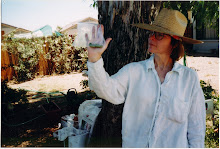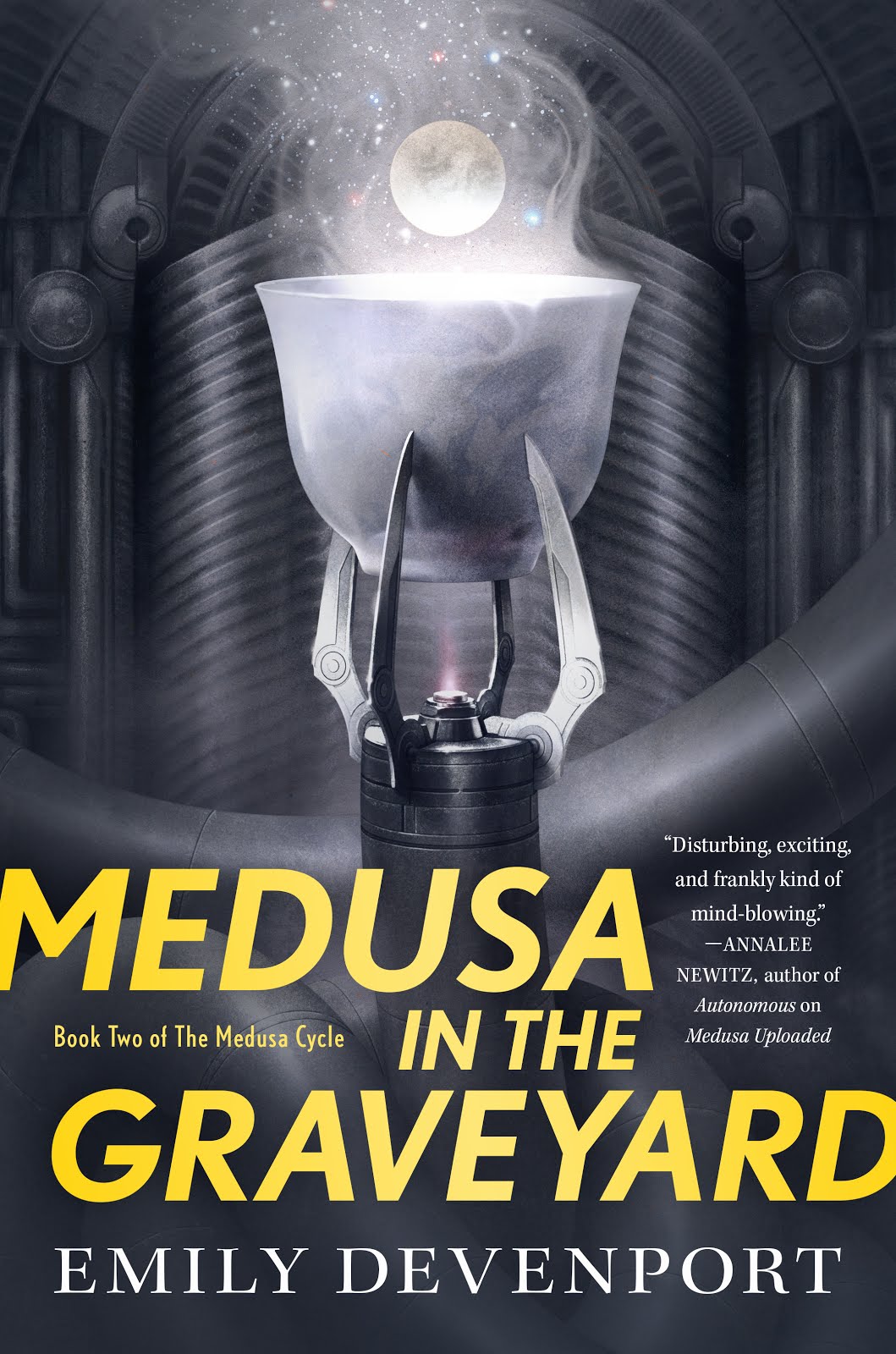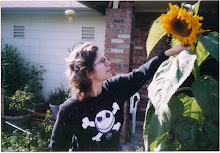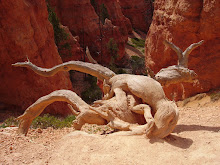Wednesday, May 30, 2012
Oak Creek Canyon, Vortex Of Fabulosity
As
Ernie and I drove south toward Sedona on HWY 89, I mused about all of
the years I've been visiting that spot. No doubt about it –
Sedona, in its pre-vortex, pre-nouveau-riche, semi-old-west-town
incarnation was a lot more fun than it is now. But Oak Creek Canyon,
Sedona's raison d'etre, remains beautiful, magical, and delightful.
There is no place like it on Earth, and the not-so-simple reason for
that is its geology.
It's
a small canyon – at least, compared to its giant cousin up North.
Yet it shares a lot of the same layers you see exposed in the Grand Canyon. The mnemonic to remember with that chunk of the Colorado
Plateau is this one: Know The Canyon's History – Study Rocks
That're Made By Time.
Know
– Kaibab: sandy limestone, greyish-white
The
– Toroweap: also sandy limestone, a bit darker
Canyon's
– Coconino: cross-bedded sandstone
History
– Hermit: shale
Study
– Supai: it's complicated
Rocks
– Redwall: limestone (gray, but stained red by hematite)
That're
– Temple Butte: sandy dolomite, sandstone, mudstone, and limestone
Made
– Muav: limestone
By
– Bright Angel: shale
Time
– Tapeats: sandstone
All
of those layers, starting with the Tapeats at the bottom and ending
with the Kaibab on top, are Paleozoic. In Northern and Eastern
Arizona you can find at least a few Mesozoic layers too (from the Age
of Dinosaurs): Moenkopi, Moenavi, the Chinle layer of Petrified Forest National Park, the Navajo Sandstone of Monument Valley, etc.
It gets complicated, depending on how far North and East you go.
Arizona was at the edge of the continent when a lot of this stuff
formed, so you see layers from shallow seas, sandy shores, dune-y
deserts, and river floodplains.
Ernie
and I observed the whimsical shapes into which the Moenkopi layer
likes to erode when we hiked through Wupatki. If we had continued
North on HWY 89 (or the equally delightful alternate route, 89A) we
would have seen more of this layer in Utah. Heading South on 89, we
dropped in elevation, losing any hint of the dinosaur age, but
discovering some interesting layers in Oak Creek Canyon that are not
seen in the Grand Canyon. The east side of the fault that forms Oak
Creek Canyon is topped by a thick basalt layer, a lava flow. But the
Kaibab, Toroweap, and Coconino layers were eroded on this side of the
fault, so the layer under that is the Hermit.
Much
of the west side (1000 feet higher than the east) is topped with the
Kaibab limestone. The basement rock is the Redwall layer – a lot
of Sedona is built on that layer. Above that is the Supai, which is
actually a group of layers, mostly sandstone and mudstone. The
Hermit shale layer sits on top of that; despite its name, it is a
complicated mix of sandstone, mudstone, and conglomerate. And on top
of that is an 800 to 1000-foot-thick layer unique to the area: the Schnebly Hill formation, a series of gold and rust-red layers of sandstone,
mudstone, and limestone. The sandy parts were were once coastal
dunes.
Another
layer pinches out inside the Schnebly Hill formation, a greyish band
of Fort Apache Limestone. Coconino sandstone tops many of the
formations on the south side, but it merges in places with the
Schnebly Hill formation, giving the rocks a nifty striped appearance.
Like
the Grand Canyon, Oak Creek Canyon can surprise you as it suddenly
appears out of the landscape. This is particularly true if you
approach from Flagstaff. The North end of the canyon is hidden
among trees. Then you get to drive down the niftiest switchbacks on
Earth, observing some spots where the layers have literally been
pulverized by the fault. Invariably, when I'm driving through oak
Creek Canyon, I have to pull over to let impatient motorists pass.
For some reason, they like to zoom through this paradise, as if they
could actually be bored by the sight. Poor, doomed souls. I hope my
spirit will take this route to the Great Beyond, once I've left this
mortal form behind.
In
the meantime, this mortal form is very happy to hike various spots in
the canyon (after having eaten a delightful lunch at the Galaxy Diner
in Flagstaff). The first spot I wanted to hit was the trail near the
West Fork of the Creek. You have to pay to get into this spot –
it's not a State Park or a National Park. But it deserves to get a
little moolah for its upkeep, and I'm grateful it never draws the
same sort of crowd you would see at Slide Rock State Park. (Try
visiting Slide Rock in January if you just want to hike and don't
care about swimming – hardly anyone is there and it's spectacular.)
After
that, we headed for Midgely Bridge (or as the locals call it, Midgely
Bridgely). The climb down to the trail that begins under the bridge
is a little heart-stopping, but you get an amazing view of the fork
in the creek and of the Supai rocks. You can hike all the way down
to the creek from there, a hot proposition if it's summer and the sun
is shining. Fortunately for us, it was a cloudy spring day, so down
we went. Wildflowers and rock formations caught my eye on the way
down, and I saw some evidence of ancient hot spring activity in some
of the rocks that had eroded from higher spots.
Hiking
back up was much more of a challenge (for me, at least – Ernie is a
mountain goat), but we still had enough energy to explore a part of
the road (now a trail blocked to motor traffic) where the old bridge
used to be. It was mysterious, and hinted at other spots not often
accessed by casual hikers in the canyon. Some day, Ernie and I will
spend a season there, exploring the general area. This is my fond
ambition . . .
But
the day was waning, so we stopped at our favorite coffee joint on HWY
89, before looping back to do the spectacular drive along HWY 179.
Some of the niftiest formations reside there, and at one point the
setting sun set the rocks ablaze. I had to pull over to one of the
overlooks and snap some photos. I just managed to catch the sunset
lighting up the rocks before the light shifted and the moment passed.
My heart brimmed with satisfaction.
Sipping
iced mochas, we headed back to Phoenix on I-17. I would rather have
lingered and extended our day trip into days, weeks, months. But I
comfort myself by considering the fact that Oak Creek Canyon, Walnut
Canyon, Sunset Crater, Wupatki, Montezuma Castle, and dozens of other
wonderful spots are in my backyard.
I
just need to venture there from time to time.
Wednesday, May 16, 2012
Into The Great Semi-Known
At
mondoernesto, my husband, Ernie, wrote about our recent trip up North
to Sunset Crater and Wupatki National Monument. This was one of
those trips we needed to take to feed our souls. Money is tight
right now, and these trips are much less frequent than they used to
be. So we packed as much fun as we possibly could into one day,
starting the trip at 6:00 a.m. and ending it at 8:00 p.m.
If
I could, I would live on the road. Granted, I've never had to do
that, and maybe you get sick of it pretty past. But in my opinion,
you get a lot less sick of it if you can take your time (and if the
money doesn't run out). After we got up in the wee hours and fed the
hungry cannibals (both feline and canine), we got into our truck and
hit the road. My heart was flying.
About
an hour-and-a-half up I-17, off Exit 289, there's a turn-around that
can take you in three different directions. If you go right, you'll
get to Cliff Castle Casino. If you go straight forward(ish), you'll
get to the cliff dwellings of Montezuma Castle. And if you go left,
you'll end up at a combo gas station/fast food joint. I've come to
love that odd little hybrid at the end of the left-hand turn. We
always stop to get coffee there, get gas, and make a pit stop. It
has come to symbolize the beginning of all journeys (or at least, the
ones that go up I-17).
Montezuma Castle and Montezuma Well are both fascinating and beautiful
destinations. A peacefulness pervades the scene in both places that
leads visitors to assume an idyllic life for the people who actually
lived there, which was probably true at least part of the time.
Likewise, Walnut Canyon, which eroded out of the same top layers that
compose the walls of the Grand Canyon, is also a happy destination.
But we were bound for Sunset Crater and Wupatki, places where life
could sometimes be less than idyllic.
For
one thing, around 1045 AD, a volcano went off. It was a small one, a
cinder cone, but on the human scale that's plenty big enough. Sunset
Crater is part of the San Francisco Volcanic field – the San Francisco Peaks are what's left of a composite/stratovolcano that
blew itself up pretty much the way geologists would expect a
stratovolcano to blow – out one side, like Mount Saint Helen's or
Vesuvius. But the mix of magma in that general area is a little more
complicated than that. The stratovolcano squirted out mostly
intermediate volcanic rocks and pyroclastic flows, but Sunset Crater
started as a rift eruption, and its magma was the low-silica kind you
might expect to see on Hawaii, from one of its shield volcanoes.
This low-silica magma had a high gas content, so it created a curtain
of fire, blowing the runny lava high into the air, where it got
whipped into cinders.
The
eruption eventually became concentrated at one end and built a cinder
cone. Near the end of the eruption, two types of mafic (low
silica-high Fe & Mg) lava flows burst through the cone at the
bottom: runny pahoehoe lava and chunky Aa. And for the grand
(semi-)finalé, The volcano blew more gassy, mafic lava into the air,
out of the top, and rained cinders down on the landscape. (Those
darker cinders, higher in Fe & Mg, are called scoria.)
I
say semi-finalé, because apparently hot magma continued to rise
underground for a while, and this stuff melted enough of the
surrounding rocks to be higher in silica. When it oozed through
cracks in lava that was already cool, it acted kind of like
toothpaste. You can see examples of this squeeze-y stuff in one of
the cracks near the Lava Flow trail head.
It's
convenient to generalize about geological processes, partly to avoid
confusing people and partly to paint a broader picture. But when
you're actually confronted with the landforms in this part of
Arizona, you have to admit there's a lot we don't know. The shallow
subduction of the Farallon Plate near the end of the Mesozoic Era seems to
have drawn volcanic activity farther inland than you would normally
see it, which is why a stratovolcano ended up in Arizona. But
something even more interesting may have happened. Arizona may have
actually over-ridden the hot upwelling that was creating the rift in
the first place.
If
you look at the Atlantic Ridge System, you'll see it lies pretty much
in the middle of that ocean. It's a classic opening basin. But the
Pacific Ridge System in messier. The plates are moving apart at a
faster rate, and most of the volcanic activity in the world is
happening at the edges of those plates. Right in the middle of the
Pacific Plate, a mantle plume is steadily blasting through, creating
the Hawaiian island chain. Another plume created the Yellowstone Caldera. And if you look at New Mexico and Southern Colorado, you'll
see that an ongoing continental rift has created the Rio Grande River Valley. The Colorado Plateau continues to rise. So geologists think
we must be still moving over that hot, upwelling spot.
Since
peridotite and basalt have been found in Arizona and New Mexico, some
of that hot stuff has to have come from the mantle. These are the
nerdy thoughts that run through my mind as Ernie and I hike all over
the Sunset Crater and Wupatki trails. In Wupatki, people used the
little box canyons to divert water to their gardens. And though
there's a lot of talk these days about how hot and dry it is there,
1000 years ago there was probably more ground water, simply because
there weren't any gigantic communities nearby draining it. The
cinders that lie on top of the soil keep rainwater from running off –
they filter down into the aquifer, and emerge as springs.
The
stones used to build the dwellings were carved out of the Moenkopi formation, a wonderful mix of sandstone and shale that erodes into
whimsical shapes.
As Ernie and I hiked through the sites, I noticed that the sacred mountains could be seen from all directions. Any argument about why people settled in the area must include those mountains.
The day was only half gone. More adventures loomed on the horizon, like storm clouds . . .
COMING NEXT – OAK CREEK CANYON, VORTEX OF FABULOSITY
The day was only half gone. More adventures loomed on the horizon, like storm clouds . . .
COMING NEXT – OAK CREEK CANYON, VORTEX OF FABULOSITY
Subscribe to:
Posts (Atom)


































